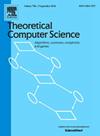Independent sets of maximum weight beyond claw-free graphs and related problems
IF 0.9
4区 计算机科学
Q3 COMPUTER SCIENCE, THEORY & METHODS
引用次数: 0
Abstract
The maximum weight independent set problem (WIS), which is known to be generally NP-hard, admits polynomial-time solutions when restricted to graphs in some special classes. In particular, due to the celebrated Edmonds' matching algorithm, WIS is solvable in polynomial time in the class of line graphs. This solution was extended to claw-free graphs and then further to fork-free graphs and to tclaw-free graphs, where tclaw is the graph consisting of t disjoint copies of the claw. The solution for tclaw-free graphs was obtained by generalizing Farber's approach to solve the problem for -free graphs. In the present paper, we elaborate this approach further to develop a polynomial-time algorithm to solve the problem in the class of fork+tclaw-free graphs, generalizing both fork-free graphs and tclaw-free graphs, and in the class of claw-free graphs. We then apply the latter result to solve the more general problem of finding a d-regular induced subgraph of maximum weight in the class of -free graphs in polynomial time for any natural d and t, extending some of the previously known solutions.
求助全文
约1分钟内获得全文
求助全文
来源期刊

Theoretical Computer Science
工程技术-计算机:理论方法
CiteScore
2.60
自引率
18.20%
发文量
471
审稿时长
12.6 months
期刊介绍:
Theoretical Computer Science is mathematical and abstract in spirit, but it derives its motivation from practical and everyday computation. Its aim is to understand the nature of computation and, as a consequence of this understanding, provide more efficient methodologies. All papers introducing or studying mathematical, logic and formal concepts and methods are welcome, provided that their motivation is clearly drawn from the field of computing.
 求助内容:
求助内容: 应助结果提醒方式:
应助结果提醒方式:


